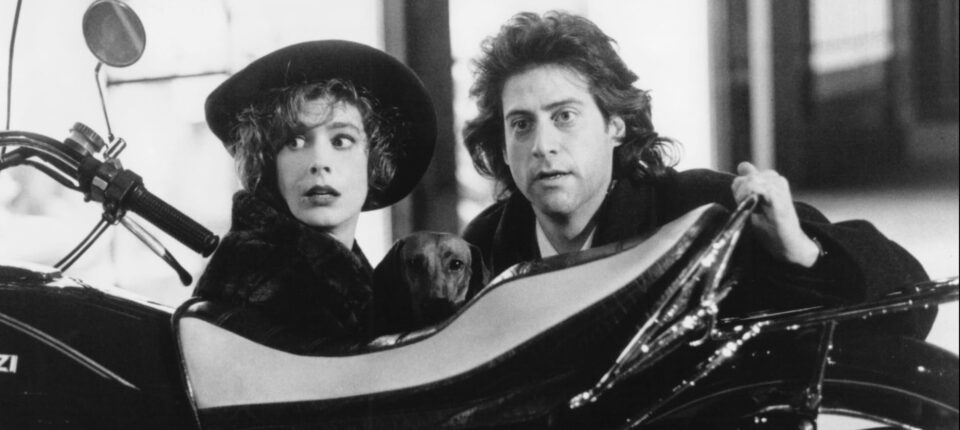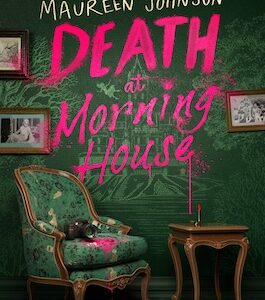After his five decades in show business, the late Richard Lewis is rightly being remembered for many career highlights: his peerless stand-up routines and late-night comedy appearances, his neurotic and oddly soulful portrayal of a fictionalized version of himself in 12 seasons of Curb Your Enthusiasm.
However, if you were a lover of mystery stories and a budding comedy nerd in the 90s, you might first have seen him chasing a dachshund across Monte Carlo. Lewis’ role in the 1992 crime caper Once Upon a Crime will not make any list of his achievements. But, briefly, he is oddly winning and wonderful in a lovable little flop of a film. It’s an improbable performance that still shows us some things about comics and the strange ways they work themselves into murder mysteries.
Once Upon a Crime is a comedic take on the “whodunnit abroad” genre. Films of Agatha Christie’s Murder Orient Express and Death and the Nile feature star-studded casts and gorgeously shot, luxurious locations. Riffing off of this model, Once Upon a Crime takes place in grand, glittering Monte Carlo. (The film is lavishly photographed by famed cinematographer Giuseppe Rotunno, who worked with famous Italian directors like Vittorio De Sica, Luchino Visconti and Federico Fellini.)
Where the big-budget Christie adaptations featured high-wattage stars from Ingrid Bergman and Penélope Cruz, Crime featured a cast of comedic actors (including John Candy, Sybil Shepherd, and Jim Belushi) each fall under suspicion for the murder of the elderly millionaire Madame van Dougen. There is even a philosophical, mustachioed detective, Inspector Bonnard (played by the wonderful Giancarlo Gianini) subbing in for Christie’s beloved Hercule Poirot. Each character is implicated: Candy’s Augie Morosco (a strangely dapper John Candy) had lost to Madame van Dougen at the casino. George Hamilton’s Alfonso, a ladies’ man, has not-so-mysterious ties to the dead woman. Belushi’s Neil Schwary (the stereotypical obnoxious American abroad), and his long-suffering wife Marilyn (played by Shepherd) are found on a train with a suitcase full of Madame van Dougen’s limbs.
You only need to look at the recent successes of Rian Johnson’s Knives Out films to see that comedy whodunnits are a popular subgenre. Once Upon a Crime is itself an adaptation of the 1960 Italian film Crimen, directed by Mario Camerini). Camerini himself remadeCrimen remade in 1971. A Hindi film, 36 ChinaTown Road, is apparently a shot-for-shot remake of Crime. The story is a particular type of whodunnit comedy, one that is not about humorusly enngineered plots or funny clues. Instead, Crime’s comedy is very character- and performance-based. It was directed by comedy legend Eugene Levy. (He makes a brief appearance as a casino cashier.) Levy’s training in improv grounds the film’s setup, where characters are placed in humorously suspicious situations where they can bounce off of each other.
On some level, everyone’s doing their job. Belushi is a back-slapping, brassily over-confident schmuck. His condescension towards Marilyn makes him small and weasely. His overweening confidence in a perfect “system” for winning at roulette draws him into the wake of another compulsive gambler, Candy’s Augie. Candy’s towering comedic talent makes the most out of this improbable man, with a brash North American accent, an oddly Continental air and the brocade robe to match. When the chips are literally down, his infantile side comes out as he and Belushi egg each other on. Shepherd’s Marilyn first seems like a put-upon simp, but it takes little more than a Versace gown and a whirl at the tables for her to come into her own. Hamilton, excels in doing what he does: his superficial charm and deep, deep tan are catnip to the town’s neglected housewives and elderly widows.
But despite the various attractions of the characters and performers, Crime’s mystery plot is flimsy at best. (It’s only 90 minutes and even that feels stretched a little thin.) The greatest whodunnits have some good twists and turns. With this small number of suspects, there’s only so many fakeouts the plot can throw your way, and the solution ends up hanging on a single clue.
But this flimsiness—for worse, but also for better–means Lewis’ performance adds substantially to the film’s charms. Lewis plays Julian Peters, a down-on-his luck actor stuck in Rome when he finds Madame Van Dougen’s missing dachshund, Napoleon. The recently-dumped Phoebe (played by Sean Young), has also spotted the dog, and hopes to bring it back to Monte Carlo and collect a hefty reward. After a bit of bickering, they agree to hop on a train and split the reward, but their plans go off the rails when they discover Madame van Dugen’s body in her garage.
Julian and Phoebe are immediately suspected by the police, but they are the only characters we know couldn’t have done it. (We later learn that Julian was actually on the phone with Madame van Dugan during the murder, rolling his eyes throughout.) It’s hard to imagine Lewis as a killler anyway–there’s no way his infamously high-octane neuroses could handle the guilt. (He is, however, just the guy you’d want to accidentally discover a body–Lewis’ normal level of freakout seems, in this situation, to be totally warranted.) This leaves Lewis in the slightly unusual position of the straight man compared to this collection of highly suspicious oddballs. His incredulous reactions to inncredible people and events make him an unconventional everyman.
At the beginning of the film, Lewis’ Julian is out of money and losing hope of being “the next Al Pacino.” (His claims to fame are a small role in Godfather III and a production of Cats.) In other words, the character is on just the right wavelength for Lewis’ sarcastic self-deprecation. “I’m a chronic whiner,” Julian admits, “it’s like a hobby with me.” It’s one of the moments where Lewis’ standup persona is woven into Julian’s character.
He’s still very much Lewis–there’s his signature slouchy posture and extravagant shrugs, but he’s always also something more at work. For most of his screen time, he’s bickering back and forth with Young. They bristle against each other as they babysit the dog and then run around town in a desperate attempt to avoid incriminating themselves. It seems like this was intended to be a kind of enemies-to-lovers romcom subplot; Phoebe and Julian do end up together, but that conclusion is extremely perfunctory and the film does little to plant those seeds alongside the mystery plot.
It seems like this was intended to be a larger part of the film and got pared down. (Nancy Meyers collaborated on the screenplay.) Young’s Phoebe is short-tempered and high-strung, Lewis, for once, is the one on a relatively even keel–despite his kvetching, he’s something of a lovable knight-errant who does the right (or at least the brave thing.)
In the dangerous risks that Julian grumbles through, Crime’s fluffy pastry of a film manages to capture Lewis’ essence: both his anxieties and his great warmth.

















